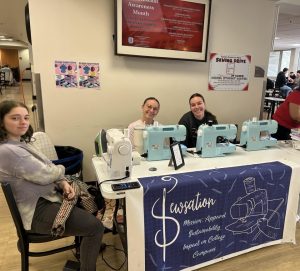Perhaps the days of sneaking in a tweet or Facebook status during class have finally come to an end. One marketing professor is making an effort to incorporate more social media in the classroom, and she’s starting by encouraging faculty to use it.
As one of the newest courses on campus, MGT 391: Social Media Marketing teaches students about firms that use Facebook, Twitter and YouTube to connect with customers.
Professor Heidi Rottier teaches the course, and she said she interacts with students through Facebook instant messaging, Instagram, Pinterest, LinkedIn and Foursquare.
“I’ve enjoyed using social media in class,” Rottier said. “I’ve found that it allows me to connect with students differently, and sometimes the new ways are very effective for both the student and me.”
For her Social Media Marketing class, Rottier’s students must blog once a week throughout the semester, participate in a class Facebook group and be active on Twitter. Additionally, students work with a local business to create a social media campaign and listen to guest speakers via Skype.
Rottier recently presented information about social media in the classroom to the Foster College of Business and Administration, where 15 faculty and staff members attended.
“Our college technology looks for opportunities to enhance the use of technology amongst our faculty,” Rottier said. “This seemed like a good forum for me to share what I’ve experienced. Plus, I love any chance to talk social media.”
Bradley isn’t the first school to embed social media in classes. A U.S. News report titled “Study: Twitter improves student learning in college classrooms” states that courses engaging students with Twitter may produce better grades and more interaction.
The study “Twitteracy: Tweeting as a New Literary Practice” was conducted at Michigan State University in October 2012. One of MSU’s professors and co-authors of the study “found that students who were actively engaging with classmates and the instructor on Twitter were more interested in the course material – and ultimately received high grades,” the article stated.
Rottier said she wasn’t aware that other professors were utilizing social media.
“One of the things I discovered in preparing for the discussion was that faculty at other institutions are also using social media in the classroom and are having great success as well,” Rottier said.
Through some research, Rottier said she found that the use of social media, when tied to classroom content, does increase student performance, retention and engagement – “all good stuff.”
“I think there are many reasons why faculty members don’t use social media for classroom purposes, and my hope in sharing [the discussion] was that I might remove a barrier or two,” she said.
Some faculty members have asked Rottier to conduct a follow-up session, which she said she’ll be happy to do.
Rottier said future social media use in the classroom creates opportunities to connect faculty and students.
“While I don’t think social media should be used arbitrarily or as a substitute for classroom interaction, I think it has a lot of potential for enhancing my ability to interact with students and teach them in a new way,” she said.








